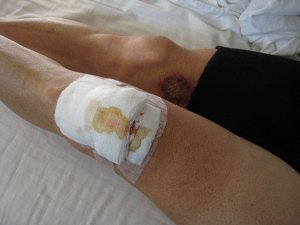While any injury or condition can be highly painful, there are undoubtedly some that are more uncomfortable than others, and that can get in the way more when you are going about your daily activities. Back pain is one of the most serious of these, and if you have back ache then you will know from firsthand experience how it can affect literally everything that you try to do – whether you are going for a jog or trying to pick something up from the floor back pain can kick in and cause you to seize up in pain.

Similarly uncomfortable is knee pain, and this can leave you unable to run, descend a flight of stairs, sit down, stand up or do anything else that involves bending your leg. This is a highly debilitating problem then and one that you need to address as quickly as possible. Normally this means rest and elevation until the swelling subsides and you can go back to moving normally without experiencing the same pain.
But what if you don’t know what is causing your knee pain? What if you’re in pain in your knee but you haven’t at any point done anything that would cause that pain? Here we will look at one of the common causes of knee pain other than injury – infection.
Types of Infection
There are several kinds of infections that can affect you around the knee. These include:
Knee Bursitis: In knee bursitis the bacteria penetrates the ‘bursae’ which are the pads located along the bones, tendons and muscles in and around the knee. This then can cause swelling in the area as well as warmth to the touch and sometimes tenderness along with pain on movement. This makes movement and placing pressure on the knee difficult.
Septic Arthritis: This is also a common infection and is a treatable form of arthritis. Here a bacterial pathogen will affect the joint of the knee which damages the surrounding structures causing inflammation. The inflammation itself causes pain, swelling and difficulty moving which worsen on exertion. This infection can also cause the symptoms of fever (body temperature 100-101 degrees Fahrenheit) which can also be accompanied by chills.
Osteomyelitis: This is an infection that affects the actual bones in the knee. This then causes deterioration of the bone as the bacteria or fungus form in the abscesses. This can also lead to obstruction of blood to the bone which causes flushing to the skin along with tenderness and pain and general fatigue for the individual. It is important to get this form of infection addressed as early as possible to limit damage to the bone and surrounding structures.
Cellulitis: Cellulitis occurs when the skin rather than the structure of the joint is affected. This then causes discoloration of the skin which can cause it to appear red or even black in patches. The area will also be swollen and warm to touch and the individual will again feel symptoms similar to having a cold or flu which can worsen on physical exertion.
Causes
The causes of infection to the knee are varied and based on many factors. The main cause of infection is that bacteria has infected the joint or skin causing the immune system to try to combat it by rushing fluids to the area. Usually this infection is caused due to contact with the bacteria, injury or accident, and low immune system. For instance then, osteoarthritis may occur in a joint that has been injured and the patient will be most susceptible when they are unwell. If someone is suffering from flu for instance and has a knee injury then this can cause infection.
Skin infections meanwhile are caused when bacteria such as the ‘staphylococcus’ bacteria comes into contact with broken skin. This bacteria can exist on the skin of healthy individuals without causing any symptoms, and in fact around 1/3rd of healthy adults have the bacteria on their skin. It is only then when that bacteria comes into contact with a cut or graze that the infection sets in.
To avoid infection then, be sure to treat injuries as soon as possible and to get plenty of rest. Disinfect any broken skin and avoid unnecessarily touching it while being sure to dress it up with a bandage or plaster. Make sure you get plenty of rest when you feel unwell, and boost your immune system with vitamins and minerals.
Treatment
In most cases of a knee infection treatment will involve the administration of antibiotics in order to fight the bacteria and drive it out of the body. You may also be given corticosteroids in order to help lessen swelling, and in some cases fluids will need to be drained from the region. In some cases surgery and even artificial structures might be needed to help repair damage to the tissue or bone – for instance a plastic kneecap.




THE ARTICLE IS GOOD, NO COMMENT, I AGREE
My husband fell 2 weeks ago and after horrific swelling that was drained was found to have an e-coli bacterial infection in the joint. The swelling was drained and left with a compression drain on it for 2 days. He is now in a rehab hospital receiving IV meds to combat the infection. The swelling in his leg has gone down to his ankle and along his calf. I do not feel the doctor is being aggressive enough in treating this condition further and I need help. The condition seems, by description, to be septic arthritis. I am at great difficulty because my husband is now 90 miles away and I can only get there twice a week. Thank you for allowing me to explain.